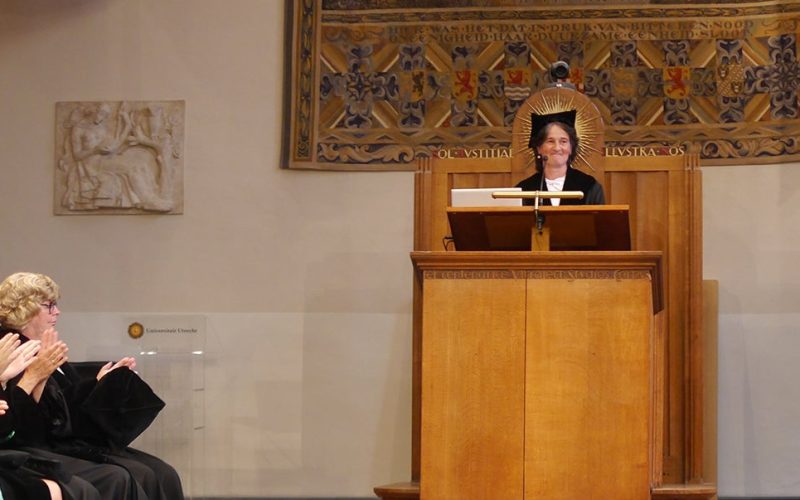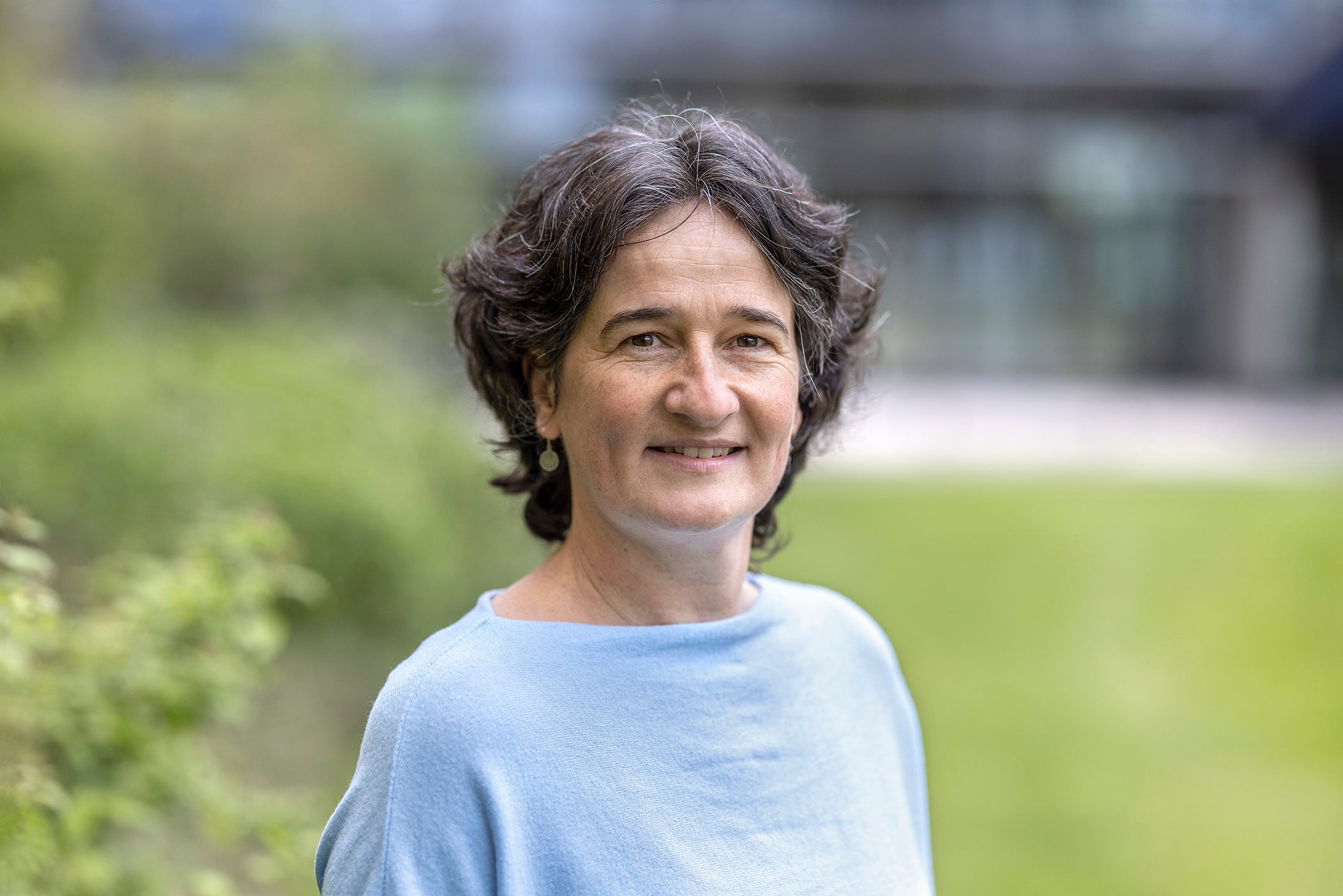On June 21, 2023, José Borghans – professor of Quantitative Immunology at the Center for Translational Immunology at UMC Utrecht – held her inaugural lecture titled “The Power of Simplicity.” Her interdisciplinary research group, which she co-leads with Kiki Tesselaar, uses a combination of experimental work and mathematical modeling to understand the complexity of the immune system.
Lees artikel in het Nederlands >
The human immune system is a hugely complex assembly of many billions of cells and molecules that together must make decisions about life and death. It is exposed to all kinds of stimuli throughout the day and must constantly decide whether it is better to respond to these or not. José Borghans illustrated this in her lecture with a few examples: “For example, the immune system does have to react to the coronavirus, even though our body had never come into contact with it before 2020, but it must above all not react to the body’s own molecules. And while it does have to react to bacteria such as Salmonella in spoiled food, we do not want it to react to the food itself, even if we have never eaten it before.” These are tough decisions that can be made thanks to an intriguing and complex communication between all those billions of cells and molecules that make up our immune system. Detailed study of this, according to Borghans, cannot be done without using mathematical models. The use of mathematics has already long been the norm within physics and chemistry. No quantum mechanics or theory of relativity, for example, would have been developed without mathematics. However, within biology – and within immunology in particular – mathematics has only recently gained a foothold, according to Borghans.
Besides helping to provide simplicity and insight into the complexity of the immune system, mathematical models help to make immunology more quantitative. They give a sense of measure and figures, such as numbers and rates. It is precisely this quantitative information about the immune system that is often still lacking. Borghans says, “It is amazing what technical masterpieces we are capable of within immunology, while even the most fundamental quantitative knowledge is often lacking. For one of our models, for example, we needed to know how long a T cell lives. That didn’t have to be very precise, but we needed to know whether we should think in terms of days, months or years. When I presented that question to some immunologists, I was stunned by their responses. Whereas one immunologist confidently claimed that a T cell lives on average about 2 weeks, another was able to tell me with equal firmness that the lifespan of a T cell is about 20 years. How could it be that we had no answer to such a basic question, while at the same time trying to understand how these cells get disrupted during infections, or why the immune system recovers so slowly after a stem cell transplant?
Finally, using in vivo deuterium labeling as well as mathematical modeling, Borghans and her colleagues were able to deduce how often T cells divide and how long they live. This information has already provided important basic insights: among other things, they have shown that the T cells responsible for immunological memory live for only a few months, while they often provide lifelong protection. Before these T cells die, they pass on what they have learned to their daughter cells so that the information is not lost. Naïve T cells – that is, the cells that have never recognized anything in our body before – appear to live for a very long time, about 6 to 9 years on average.
Meanwhile, according to Borghans, it is more than clear that quantitative immunology has a great future: there is hardly a laboratory that does not produce Big Data, and therefore the demand for mathematical knowledge has grown enormously and mathematical analyses are increasingly being applied within immunology. Borghans says: “I am convinced that we can make significant progress by combining experimental work and modeling on a much larger scale. That requires close cooperation between researchers from different disciplines, and we have to have the courage to stimulate that. What is needed is Team Science. The prevailing norm within the academy is still that there is one principal investigator per research group. However, to solve complex issues, this is often no longer sufficient. We cannot expect that all the necessary expertise can always be provided by one person. It is precisely by working together, sharing expertise and looking at a problem from different angles that we make progress. Collaboration is our strength!”
However, Team Science, according to Borghans, is thwarted by the fact that many grants and awards are distributed according to a competitive model, with excessive emphasis on the individual. Instead of collaboration, this encourages competition. Discussions about authorships, for example, regularly become overheated because one’s career prospects and the likelihood of receiving grants depend directly on it. Borghans: “The fact that within Biomedical Sciences most value is placed on first and last authorships gets in the way of Team Science. And we all act as if there is nothing we can do about it, but of course that is nonsense. Within other fields, habits are often quite different. Why don’t we always put the list of authors in alphabetical order? A concrete description of every individual’s contribution can do justice to the differences that undoubtedly exist between authors and that are allowed to exist. In such a model, everyone gets the credit he or she deserves, and teams can work together much better and with more pleasure.”
Photo by Ed van Rijswijk
José Borghans leads an interdisciplinary research group together with Kiki Tesselaar, focusing mainly on the quantification of leukocyte dynamics. She was trained as a theoretical immunologist at Utrecht University and received her PhD in 2000 on studies of lymphocyte and MHC diversity. After her PhD, she worked in experimental immunology laboratories, aiming to bridge the gap between “wet” laboratory experiments and mathematical modeling. Funded by a Marie-Curie Fellowship, she worked as a postdoc at the Institut Pasteur in Paris studying lymphocyte homeostasis. During a later postdoctoral period, funded by an NWO Veni grant, she worked at Sanquin Research in Amsterdam studying lymphocyte dynamics in HIV infection.
José Borghans has worked at UMC Utrecht since 2004, was appointed associate professor in 2009 and professor of Quantitative Immunology in 2021. Her interdisciplinary research group facilitates the close integration of experimental and mathematical immunology. Using advanced immunological techniques, including in vivo stable isotope labeling, the group studies the dynamics of different types of leukocytes in homeostasis, during aging and in various diseases (such as leukemia, HIV infection and after stem cell transplantation). Thanks to a recent NWO Vici grant, the group is currently investigating the dynamics of T cells in tissues. In addition, Borghans leads the CTI’s Computational Immunology Core, which brings together all researchers using mathematics or bioinformatics to study the immune system.

